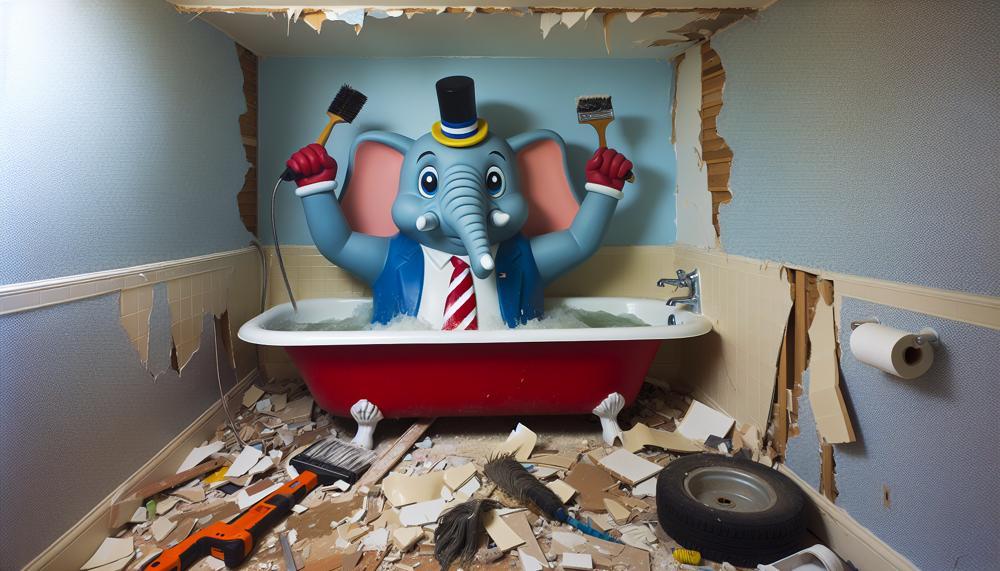Are you fed up with your outdated bathtub and ready to give your bathroom a much-needed makeover? The thought of removing a bathtub may seem overwhelming, especially when it comes to protecting the tiles surrounding it.
We have some invaluable tips and tricks to help you successfully remove your bathtub without causing any damage to those beautiful tiles.
In this guide, we will guide you through the process step by step, highlighting crucial points such as:
- The significance of proper preparation before beginning the removal process
- Various methods for removing a bathtub without harming the surrounding tiles
- Essential tools and materials required for the job
- Tips for avoiding common mistakes that could result in tile damage
- How to effectively clean and repair any potential tile damage after removing the bathtub
Bid farewell to the stress and worry of damaging your bathroom tiles during a bathtub removal.
With our expert guidance, your bathroom will be transformed into a modern oasis in no time.
So, let’s dive in and discover how to remove a bathtub like a pro.
Contents
- 1 Why Should You Want to Remove a Bathtub?
- 2 Assessing the situation
- 3 Preparing for the removal
- 4 Removing the bathtub
- 4.1 Step one: Gather the Necessary Equipment
- 4.2 Step two: Turn Off Water Supply
- 4.3 Step three: Remove Tub Drain Flange
- 4.4 Step four: Disconnect Waste and Overflow Valve
- 4.5 Step five: Remove Tub Spout
- 4.6 Step six: Disconnect Water Lines
- 4.7 Step seven: Lift and Slide Out Tub
- 4.8 Step eight: Be Aware of Potential Errors
- 5 Repairing or replacing damaged tiles
- 6 Conclusion
Why Should You Want to Remove a Bathtub?
There are numerous potential advantages to eliminating a bathtub, such as freeing up space, simplifying cleaning, boosting a home’s value, and reducing water costs.
However, it is essential to thoroughly weigh the possible drawbacks, such as devaluing a home and incurring expensive repairs, before deciding to remove a bathtub. If removal is necessary, it is wise to replace it with another attractive feature for prospective buyers.
To remove a bathtub without causing harm to the surrounding tiles, careful planning and execution are essential. This includes seeking professional advice and choosing a replacement option beforehand.
It is also crucial to assess the condition of tiles, grout, and installation method beforehand. Shutting off the water supply and draining the tub before beginning the removal process is also vital.
Assessing the situation
When it comes to removing a bathtub, assessing the situation is crucial in order to avoid damaging the surrounding tiles. To ensure a successful removal process and minimize potential damage, here are some steps you can follow:
- Consider the age and condition of the tiles: It’s important to take into account the age and condition of the tiles before beginning the removal process. Older and more worn out tiles may be more fragile and prone to damage.
- Check the state of the grout: The condition of the grout can also affect how easily the tub can be removed without damaging the tiles. Loose or deteriorating grout may make the removal process easier, but if it is in good condition, extra care must be taken.
- Seek professional advice: It is always recommended to consult with a professional or contractor before attempting to remove a bathtub. They can assess the situation and provide guidance on whether it is feasible to remove the tub without causing damage to the tiles.
- Plan for replacement options: Before starting the removal process, have an idea of what you want to replace the tub with. This will impact how you approach the removal and potential damage to surrounding tiles.
- Shut off water supply: Make sure to shut off the water supply and remove any debris from the tub before beginning any work. This will make it easier and safer to remove.
- Gather necessary tools and supplies: Having the right tools on hand is crucial for a successful removal process. Some tools that may be needed include a pry bar, hammer, drill, and protective eyewear.
- Use caution when loosening caulk or sealant: Before attempting to remove the tub, carefully loosen any caulk or sealant around the edges. This will help prevent damage to surrounding tiles.
- Remove screws or nails holding tub in place: Use a drill to carefully remove any screws or nails holding the tub in place. Take your time and use caution to avoid damaging the tiles.
- Lift out tub carefully: With all screws or nails removed, carefully lift out the tub. It may be helpful to have someone assist you, especially if the tub is heavy.
- 10. Prepare for potential damage: Despite careful planning and execution, there is always a chance of some damage occurring to surrounding tiles during the removal process. Have repair kits or replacement tiles on hand in case of any issues.
By following these steps and assessing the situation before removing a bathtub, you can minimize potential damage and ensure a successful removal process.
Preparing for the removal
Before starting the actual removal, it is crucial to turn off the water supply and disconnect any plumbing fixtures. This precaution will prevent any water damage or accidents during the removal process.

Having all necessary tools and materials ready before starting the removal process is also essential. This includes a utility knife, pry bar, hammer, gloves, and eye protection.
When loosening caulk or sealant around the edges of the bathtub, it is vital to use caution not to damage the surrounding tiles. This can be done using a utility knife or razor blade.
Once all the caulking has been removed, it is time to carefully loosen and remove any screws or nails holding the tub in place. Working slowly and cautiously will help prevent any damage to the tiles.
Despite taking all necessary precautions, there is always a chance that some tiles may get damaged during the removal process.
Being prepared for this possibility and having replacement options ready will help avoid any delays or setbacks in completing the project.
Removing the bathtub
Removing a bathtub is an intimidating task, however, with the appropriate measures and precautions, it can be accomplished safely and efficiently without causing harm to the surrounding tiles. Here are the essential steps that you should follow:
Step one: Gather the Necessary Equipment
Before beginning the removal process, ensure that you have all the required tools and supplies. These include a utility knife, a tub drain wrench, a screwdriver, a wrench, a pry bar, and 1×4 boards.
Step two: Turn Off Water Supply
Before removing the bathtub, make sure to turn off the water supply and drain any remaining water in the tub.
Step three: Remove Tub Drain Flange

Using your utility knife, cut through the grout joints around the tub drain flange. Then, use a tub drain wrench to loosen and remove the screws holding the flange in place.
Step four: Disconnect Waste and Overflow Valve
Next, use a screwdriver to disconnect the waste and overflow valves from the tub.
Step five: Remove Tub Spout
If your bathtub has a separate spout, you will need to remove it as well. This can generally be done by loosening the threaded nipple or set screws.
Step six: Disconnect Water Lines
Using a wrench, disconnect the water lines from the tub. Make sure to have a bucket nearby to catch any water that may still be in the lines.
Step seven: Lift and Slide Out Tub
With all connections removed, carefully lift and slide out the tub. To avoid damaging tiles, use 1×4 boards as skids to support the weight of the tub.
Step eight: Be Aware of Potential Errors
During the removal process, it is imperative to be cognizant of potential mistakes that can cause damage to surrounding tiles.
These may include improper disconnection of pipes and inadequate support for the weight of the tub.
Repairing or replacing damaged tiles
When faced with the task of repairing or replacing damaged tiles in a bathtub, it may appear daunting. However, with the right tools and techniques, it can be done effectively without risking damage to the surrounding tiles.
Follow these steps to effectively repair or replace damaged tiles on a bathtub.
- Gather essential tools and materials: Before beginning any project, it is crucial to gather all necessary tools and materials. This includes a hammer, chisel, putty knife, tile adhesive, grout, sponge, and safety glasses.
- Extract grout around the damaged tile: Use a grout saw or utility knife to carefully remove the grout surrounding the damaged tile. This will enable you to remove the tile without harming neighboring tiles.
- Break up the damaged tile using a hammer: Once the grout is eliminated, use a hammer and chisel to cautiously break up the damaged tile. Wear safety glasses and work slowly to avoid damaging nearby tiles.
- Remove any remaining adhesive from the surface: After removing the tile, use a putty knife to scrape off any remaining adhesive from the surface. This will ensure proper adhesion of the new tile.
- Prepare the new tile by applying adhesive: Apply tile adhesive to the back of the new tile using a notched trowel. Spread the adhesive evenly and cover the entire surface of the tile.
- Place new tile in position and press down firmly: Carefully place the new tile in position and press down firmly for proper adhesion.
- Allow the adhesive to dry before grouting: Give the adhesive 24 hours to dry before moving on to grouting.
- Fill in grout lines with grout: Use a grout float to fill in gaps between tiles with grout.
- Wipe away excess grout with damp sponge: Use a damp sponge to wipe away any excess grout from the tiles, preventing it from drying and leaving a hazy film on the surface.
- Allow grout to dry before cleaning the surface: Allow the grout to dry completely before cleaning the surface with a damp cloth.
By following these steps, you can effectively repair or replace damaged tiles in a bathtub without causing any harm to the surrounding tiles.
Conclusion
In conclusion, removing a bathtub without causing damage to the surrounding tiles may seem like a daunting task.
However, with proper preparation and techniques, it can be accomplished successfully. First and foremost, it is crucial to assess the condition of the tiles and seek professional advice before beginning the removal process.
This will ensure that you are fully aware of any potential risks and can take the necessary precautions.
Next, gather all the necessary tools and materials before starting the removal process. This includes protective gear such as gloves and goggles, as well as tools like a utility knife and pry bar.
Additionally, taking caution during the removal process is key to avoiding any accidental damage to the tiles.
It is also important to be prepared for potential damage to the tiles, despite your best efforts. In such cases, there are repair kits available that can help fix any cracks or chips in the tiles.
If necessary, replacement options are also available for severely damaged tiles.





